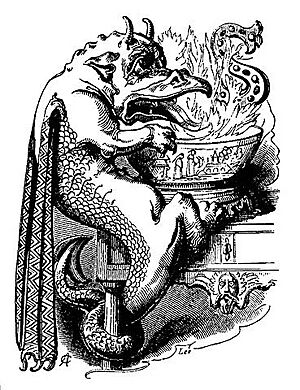Snap-dragon (game) facts for kids
Snap-dragon was a super fun and exciting game played a long time ago, starting around the 1500s! People often played it during the winter, especially on Christmas Eve. Imagine a wide, shallow bowl with a special liquid that could be set on fire. They would put raisins into this liquid, then light it up! To make it even more exciting, they would turn down the lights. This made the blue flames look really cool and a bit spooky.
The main idea of the game was to quickly grab the raisins out of the burning liquid. You had to be fast! As soon as you snatched a raisin, you'd close your mouth to put out any flames on it, then eat it. One person who wrote about the game said it was funny to see everyone's faces look like a "demon" as they reached into the flames. Snap-dragon was popular in places like England, Canada, and the United States.
Contents
How to Play Snap-dragon
Playing Snap-dragon needed just a few things to get started.
What You Needed
The main liquid used was usually a type of spirit that could burn, but any similar liquid that caught fire easily would work. The most common treats to grab were raisins, especially a kind called Málaga raisins. But players also used other yummy things! These included almonds, currants, candied fruit, figs, grapes, and plums. Sometimes, a little salt was sprinkled into the bowl to make the flames look even more interesting.
The game was played in a low, wide bowl. This bowl was usually placed in the middle of a table. This helped make sure that any drops of the burning liquid didn't splash onto other things. In one fun version, a Christmas pudding was put in the center of the bowl, with raisins all around it!
Fun Traditions and Beliefs
Snap-dragon was mostly a Christmas game, but some people also played it for Halloween or Twelfth Night. It was a game full of traditions and even some superstitions!
Lucky Raisins and Wishes
One belief was that the person who grabbed the most treats from the flames would find their true love within a year. Another cool tradition involved a "lucky raisin." One of the raisins in the bowl would have a small gold button hidden inside it. If you were the lucky one to find this raisin, you could ask for a special reward or a favor of your choice!
There's a story about young Prince Charles (who later became King Charles I of England) playing Snap-dragon. He found the lucky raisin and, as his wish, asked for the famous explorer Walter Raleigh to be set free.
The Snap-dragon Chant
The game often came with its own special chant! People would say these words while playing:
Here he comes with flaming bowl,
Don't he mean to take his toll,
Snip! Snap! Dragon!
Take care you don't take too much,
Be not greedy in your clutch,
Snip! Snap! Dragon!
With his blue and lapping tongue
Many of you will be stung,
Snip! Snap! Dragon!
For he snaps at all that comes
Snatching at his feast of plums,
Snip! Snap! Dragon!
But Old Christmas makes him come,
Though he looks so fee! fa! fum!
Snip! Snap! Dragon!
Don't 'ee fear him but be bold –
Out he goes his flames are cold,
Snip! Snap! Dragon!
Where Did Snap-dragon Come From?
People had many ideas about where the game of Snap-dragon first started.
Old Stories and Myths
One old play from 1607, called Lingua, said the game came from ancient times. It suggested that after Hercules defeated a flaming dragon, he created this "fiery meat" game to remember it. Another story linked the game's fire to Saint George and the dragon. Some even thought it might go back to ancient druidic fire-worship.
It's also thought that the name "snapdragon" might have come from a dragon's head puppet with snapping jaws. These puppets were carried by mummers (performers) during Christmas plays.
The Science Behind the Flames
A famous scientist named Michael Faraday explained how Snap-dragon worked in his book The Chemical History of a Candle (1860).
How the Flames Worked
Faraday suggested that the raisins in Snap-dragon acted a bit like tiny wicks. The liquid would burn, but it wasn't hot enough to burn up the raisins themselves. It's similar to how some desserts, like Christmas puddings, have burning liquid on top. The liquid burns, but the food underneath stays safe.
Even though it was a fun game, sometimes players, especially children, would accidentally burn their hands or mouths. Because of these safety concerns, the game mostly stopped being played by the early 1900s. However, some families kept the tradition alive for many years after that!
Images for kids



